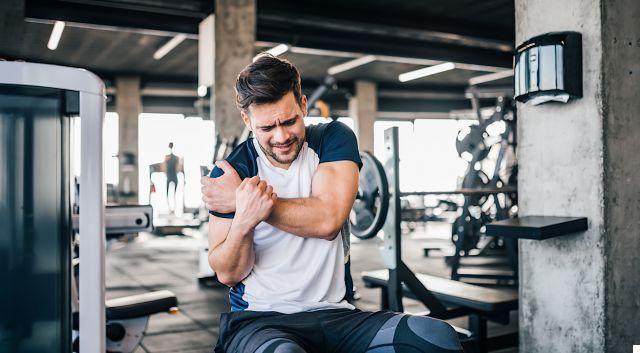
Index of Articles
Lateral raises with dumbbells or cables
Also called openings, they present risks linked to the bad habit of using loads well beyond one's capabilities.
To lift them, you compensate for your lack of strength by reducing the lever arm by flexing your forearm by 90 ° and making real "kidney strokes". The negative part of the exercise is made to disappear and only the positive is done by slanting the back, with an accelerated and uncontrolled movement, clearly damaging to the spine. Paradoxically, it is curious to point out how girls in general, on the contrary, perform it at underestimated loads.
Side openings at 90 °
There are several and widespread errors of execution related to this movement. But in relation to the aspect we are dealing with, that is the trauma profile, here the risk of "getting hurt" occurs when performing without rest your forehead on a backrest. This results in constant tension on the stabilizing muscles of the trunk, with the risk of inflammation and soreness in the long term. Not only; if you do not keep your back straight, you risk rachid trauma already mentioned for deadlifts and good morning. It remains to underline the incorrect habit already mentioned for the lateral openings in orthostatic, of loading excessive weights, compensating with the reduction of the lever arm and helping with back blows.
Nothing in particular to report for Horizontal Extensions of the Homers to the Specific Machine.
Front Raises
Also called Sagittal Flexions of the Arms, they have traumatological potentialities that derive from the same execution errors of the lateral openings. In this case, then, we have an exacerbation of the problem as the arm raised anteriorly increases the torque, therefore the pressure on the spine with consequent ample effort of the lumbar and abdominal muscles for stabilization. As long as suitable loads are used, nothing frightening, but even in this case it is common to use excessive loads, carried up with "kidney blows" and without negative phase. The risk of trauma to the spine (herniations, protusions, inflammation, back pain, etc.) is therefore often even acute in nature.
Vertical Rowing
Also known as Vertical Lifting with Narrow Grip Barbell or Pulls or Brings to the Chin. The same observations mentioned for lateral openings and lateral openings with a bent torso apply. It should also be noted that the movement close to the body involves the flexion of the hands. This should never be accentuated especially in the presence of heavy loads in order to avoid inflammation of the wrist tendons.
Shoulder Press
Also known as Pushes or Stretches Over the Head, in the slow back and slow forward variants, with dumbbells or barbell, it presents various risks of injury in, some obvious, others less known:
- Since it is a pushing movement, what is mentioned for the bench press applies to the wrist joint and I refer you to it so as not to repeat;
- The version with descending part behind the nape involves the retroversion of the humerus. If you do not have flexible internal rotators and a sturdy rotator cuff, you risk inflammation from rubbing, dislocations. Clearly therefore not recommended for those with a history of pathologies behind them. It is advisable to carry out frequent stretching for internal rotators and shortening exercises for external rotators of the humerus with adducted arm and with cable grip
- The nature of the exercise involves significant pressure along the longitudinal axis of the vertebrae, with exacerbation of the physiological curves between the sternum and coccyx. Therefore it is contraindicated to anyone suffering from pathologies affecting the spine. Everyone should avoid accentuating the lumbar lordosis during the push, rather, flatten the vertebrae at the back. The risk of inflammatory spinal pathologies is quite frequent due to the habit of arching the back in the final repetitions;
- The standing version is more training and productive in terms of anabolic and cardiovascular stimulation, but carries a large margin of risk of acute trauma. It is essential to control the center of gravity in the phase of maximum elevation of the barbell, since the risk of falling backwards is significant, as is the sudden hyperlordotization of the spine with immediate herniation. The problem is partially obviated by keeping one leg bent one step forward, and the other straight and with the sole of the foot firmly, one step back, in a configuration that remotely resembles a lunge. I don't know why we write so much about the squat and very little about the thrusts above the nape, since the latter deserves a lot of attention as it is significantly anabolic, and because it is more potentially dangerous than the squat.


























